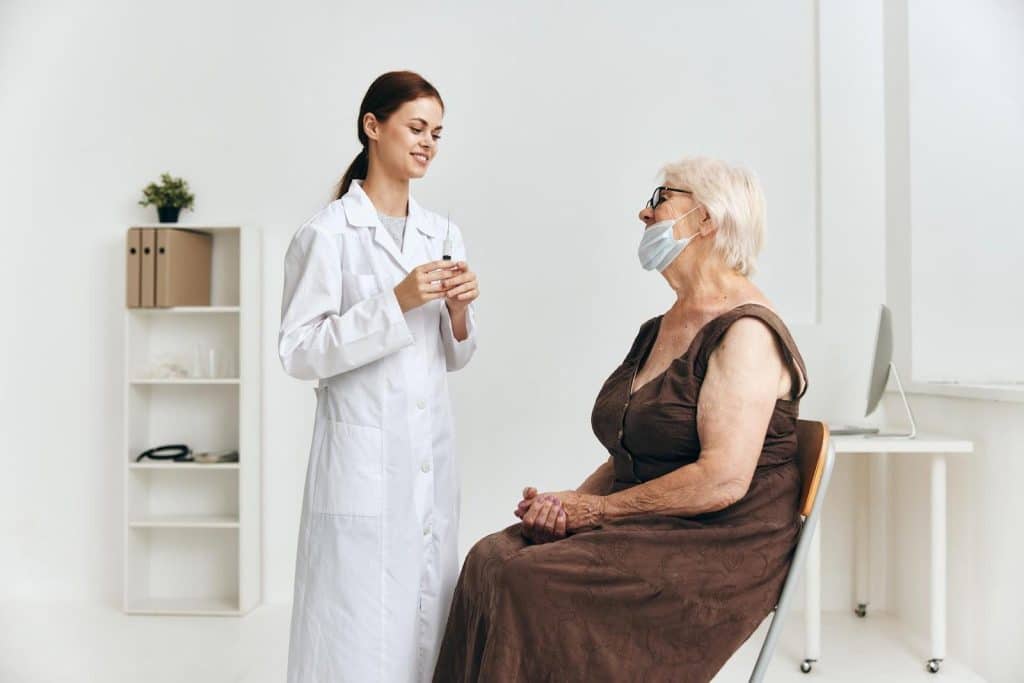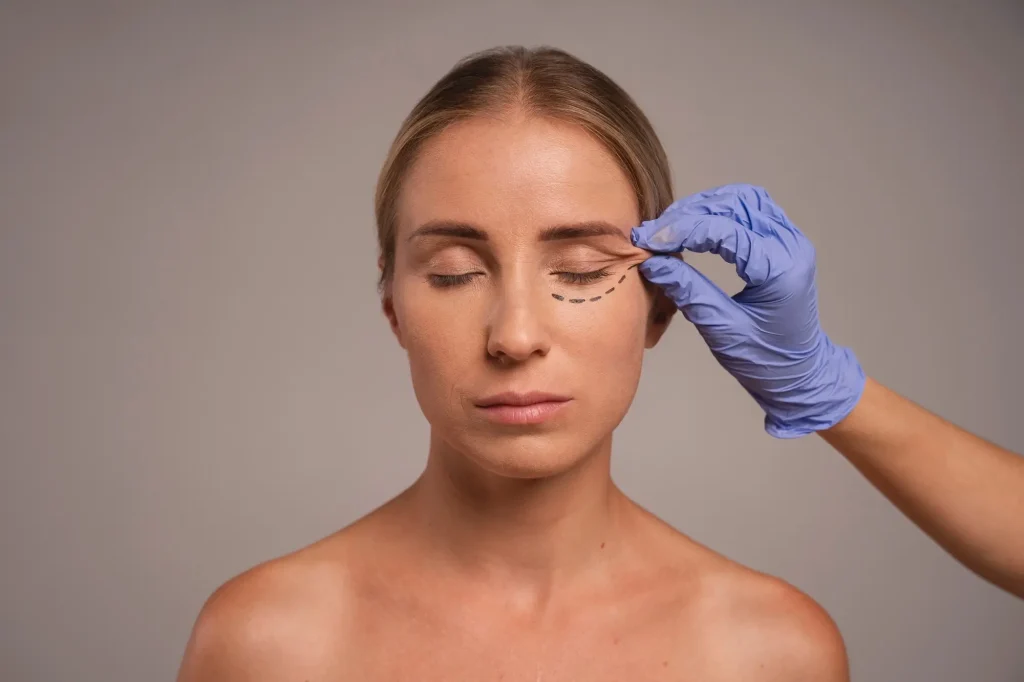A study published in the Plastic and Reconstructive Surgery journal reveals that our eyebrows shift as part of the natural aging process, with the inner brow creeping upwards while the corners stay put. Though subtle, this change can significantly alter one’s facial expression and perceived age.
Dysport is an FDA-approved injectable that solves this common aging concern. By relaxing the muscles that cause frown lines and eyebrow drooping, Dysport provides a non-surgical approach to rejuvenate the brow area, resulting in a more youthful and refreshed appearance.
This article will delve deeper into how experts use Dysport for brow lifts. We’ll explore the treatment’s effectiveness, safety, and duration of results to give patients and professionals a detailed understanding of Dysport.
Key Takeaways
- Dysport injections can be an effective and minimally invasive option for achieving an eyebrow lift.
- Understanding the anatomical factors influencing brow position is crucial for successful Dysport treatment.
- Patient selection criteria should include an assessment of expectations, goals, and realistic outcomes.
- Injection techniques for Dysport eyebrow lift require precision and an understanding of brow anatomy.
- Managing patient expectations and addressing potential complications are essential for optimal outcomes.
About: Medical Spa RX provides medical practices with premium products at the best prices. If you’re looking to buy Dysport wholesale for your practice, the sales representatives at Medical Spa RX can give you guidance.
Anatomical Factors Influencing Eyebrow Position
Our eyebrows play a significant role in nonverbal communication, influencing expressions and conveying emotions. The position and shape of our brow are not just a result of grooming; they are deeply rooted in our anatomy, affected by the aging process, and influenced by our genetic makeup. Here’s a detailed look at these factors:
The Role of Facial Muscles in Eyebrow Positioning
Facial muscles play a pivotal role in the positioning of the eyebrows. The frontalis muscle is primarily responsible for elevating the eyebrows, while the corrugator supercilii, orbicularis oculi, and procerus muscles contribute to their depression.
The interplay between these muscles allows for various expressions and nonverbal communication. These muscles produce different eyebrow positions by contracting and relaxing in multiple combinations. Neuromodulators can alter this dynamic, affecting eyebrow position for aesthetic purposes.
How Aging Affects Eyebrow Position

Aging impacts eyebrow position in several ways. Over time, motor recruitment to the facial muscles decreases, affecting how high or low eyebrows sit on the face. Studies have shown that vertical movement at the landmarks of the eyebrows decreases with aging.
The proteins responsible for skin elasticity and firmness, namely collagen and elastin, also decrease because of age. This loss of support allows the eyebrows to droop downwards, sometimes even partially obstructing vision. Additionally, the frontalis muscle can weaken with age, making it harder to raise the eyebrows as effectively.
The Impact of Genetics on Eyebrow Shape
The shape of our brow, independent of their position, is primarily determined by genetics. Our DNA influences the brow bone’s structure, hair follicle distribution, and skin thickness.
These genetic factors contribute to the diversity of eyebrow shapes we see across individuals. Some have naturally high arches, while others have straighter or more rounded eyebrows. Additionally, factors like hair color and density play a role in the overall appearance of the brows.
Understanding the anatomical factors influencing eyebrow position can help us appreciate the intricate interplay of muscles, aging, and genetics in shaping facial expressions.
Patient Selection Criteria for Dysport Eyebrow Lift

Dysport, a neuromodulator similar to Botox, offers a non-surgical option for achieving a subtle eyebrow lift. However, it’s not a one-size-fits-all solution. Selecting suitable patients for a Dysport eyebrow lift is crucial for achieving optimal results and patient satisfaction. Here’s a detailed look at the criteria and considerations involved in this process:
Assessing Patient Expectations and Goals
The first step involves a thorough consultation with a qualified healthcare professional. During this discussion, the doctor will delve into a patient’s:
- Desired Outcome: What do they hope to achieve with a Dysport eyebrow lift? Is the patient looking for a more youthful appearance, improved symmetry, or a slight arch elevation? Doctors can also show images of Dysport before and after in the eye area, helping their patients know what to expect from the treatment.
- Medical History: Does the patient have any underlying medical conditions or allergies that might contraindicate Dysport injections?
- Previous Cosmetic Procedures: Has the patient undergone any prior cosmetic procedures in the eyebrow area? This information helps healthcare professionals assess potential interactions.
Understanding a patient’s expectations allows the doctor administering the procedure to determine if Dysport is the most suitable approach. Discussing alternative options like surgical brow lifts is crucial if a patient’s desired outcome exceeds what Dysport can achieve.
Identifying Suitable Candidates for Dysport Injections
Ideal candidates for Dysport eyebrow lifts are adults under 65 who are in good health and have dynamic wrinkles caused by facial expressions, such as frown lines, crow’s feet, and forehead creases. Healthcare professionals must evaluate the patient’s skin condition, degree of aging, and specific concerns to determine if Dysport can meet their goals.
Managing Patient Concerns and Addressing Realistic Outcomes
Managing patient concerns involves setting realistic expectations and being transparent about the potential risks and limitations of the procedure. During the consultation, healthcare professionals can explain to patients that while Dysport can significantly improve the appearance of wrinkles and a subtle lift to the eyebrows, it is not a replacement for surgical interventions, and the results are temporary.
Moreover, the consultation stage should allow patients to communicate their concerns and questions about the treatment. They can ask who makes Dysport so they can understand the treatment’s safety profile better. Additionally, doctors should inform patients about potential side effects, such as mild discomfort, redness, or swelling at the injection sites, which are usually temporary.
Injection Techniques for Dysport Eyebrow Lift

Proper injection techniques are essential for a successful Dysport eyebrow lift. Components like understanding the anatomy, selecting the right injection points, and ensuring precision are critical for the success of this procedure.
Understanding the Anatomy of the Brow Area
Before discussing injection points, a thorough understanding of these anatomical features is crucial for any cosmetic procedure involving the brow area.
- Frontalis Muscle: This extensive muscle sits beneath the forehead skin and above the eyebrows. Its primary function is to elevate the brows.
- Orbicularis Oculi Muscle: This muscle surrounds the eyes and contributes to facial expressions, including brow lowering.
- Corrugator Supercilii Muscle: Located between the eyebrows, this muscle pulls the brows down and together when contracted, forming a frown.
Selecting Appropriate Injection Points for Optimal Results
When administering Dysport for eyebrow lifts, an aesthetic specialist or healthcare professional typically injects the treatment at five points between and over the eyebrows. Though there isn’t a single, universally accepted pattern for Dysport, specialists follow two injection points above each eyebrow in the corrugator muscle and one injection point between the eyebrows in the procerus muscle.
To provide a lateral brow lift, a doctor must inject Dysport into the area with the crow’s feet, particularly the upper portion of the crow’s feet (lateral orbicularis oculi muscle). These points are selected based on the individual’s facial anatomy to achieve the desired aesthetic outcome of the brow and forehead.
It is essential to inject the correct amount of Dysport at the exact anatomical location (brow or forehead) to relax the appropriate muscles without affecting the surrounding areas. This strategy ensures a natural look and avoids complications such as drooping eyelids.
Expected Outcomes and Managing Patient Expectations
- Timeline for Results after Treatment: Following a Dysport eyebrow lift, results typically become noticeable within 2-7 days, with the full effects manifesting within 1 to 2 weeks. The results, which include a reduction in the appearance of wrinkles and a smoother complexion, can last 3 to 4 months.
- Possibility of Asymmetry: Dysport injections aim to create symmetry and a natural appearance of the forehead, but asymmetry is possible due to individual facial muscle dynamics. Practitioners should strive for precision in injection placement to minimize this risk and achieve the most natural-looking results possible.
Managing Patient Expectations for Long-Term Outcomes
Long-term outcomes of Dysport treatments on the brow and forehead are not permanent, and managing patient expectations is essential for satisfaction. Patients should understand that while Dysport can significantly improve the appearance of wrinkles, the effects are temporary, and maintenance treatments will be necessary to sustain the results.
When healthcare professionals educate patients on the nature of the treatment and the importance of follow-up sessions, it will help align their expectations with the likely outcomes from Dysport injections.
Potential Complications and Management Strategies for Dysport Treatments
Dysport eyebrow lifts are generally safe when performed by a qualified healthcare professional. However, as with any medical procedure, there’s a potential for complications. The most common complications from Dysport injections include discomfort at the injection site, bruising, swelling, headache, and, more rarely, eyelid or eyebrow ptosis (drooping).
Patients may sometimes experience muscle weakness, visual impairment, dry eyes, numbness, itching, or tingling around the forehead area. In rare cases, some patients may have allergic reactions to the ingredients in Dysport’s formulation, leading to breathing difficulties.
Strategies for Preventing and Managing Complications When Doing the Brow Lift
To minimize the risk of complications, practitioners should ensure proper injection techniques and follow-up care. Selecting the appropriate dosage and injection sites based on individual patient anatomy is crucial.
Post-procedure, patients should be monitored for adverse reactions and provided with clear instructions for care at home. If complications arise, prompt medical attention can address issues such as asymmetry or drooping.
The Importance of Patient Education and Informed Consent
Patient education is a critical component of informed consent. Patients need to understand the procedure’s risks, benefits, and alternatives. Informed consent is a legal and ethical requirement for procedures like Dysport treatments, ensuring patients make voluntary and well-informed healthcare decisions.
By thoroughly educating patients, physicians can foster a trusting relationship and help patients set realistic expectations for the outcomes of their Dysport injections.
Conclusion
Dysport injections for eyebrow lifts offer a valuable non-surgical option for individuals seeking to improve their appearance and achieve a youthful look. By understanding the anatomical factors influencing eyebrow position, employing precise injection techniques, and managing patient expectations, medical professionals can deliver optimal patient satisfaction and enhance aesthetic outcomes.
Equipping medical professionals with this knowledge empowers them to provide safe and effective treatments, ultimately upholding and prioritizing patient well-being.
FAQs
1. What is Dysport?
Dysport is an FDA-approved injectable neuromodulator that smooths fine lines and wrinkles, particularly between the eyebrows.
2. Can Dysport help with things other than eyebrow lifts?
Healthcare professionals can also use Dysport to treat various conditions, such as smoothing other expression lines, reducing excessive sweating, and treating muscle spasticity disorders.
3. How can I maintain the results of my Dysport treatment?
Consider regular follow-up treatments to maintain the results of your Dysport treatment. It’s also vital to protect the treated areas from sun damage with sunscreen, stay hydrated, and maintain a balanced diet for overall skin health.
References
Asaad M, Kelarji AB, Jawhar CS, et al. Eyebrow Height Changes with Aging: A Systematic Review and Meta-analysis. Plastic and Reconstructive Surgery – Global Open. 2019;7(9):e2433. doi:10.1097/gox.0000000000002433
Park J, Yun S, Son D. Changes in Eyebrow Position and Movement with Aging. Archives of Plastic Surgery. 2017;44(01):65-71. doi:10.5999/aps.2017.44.1.65



















